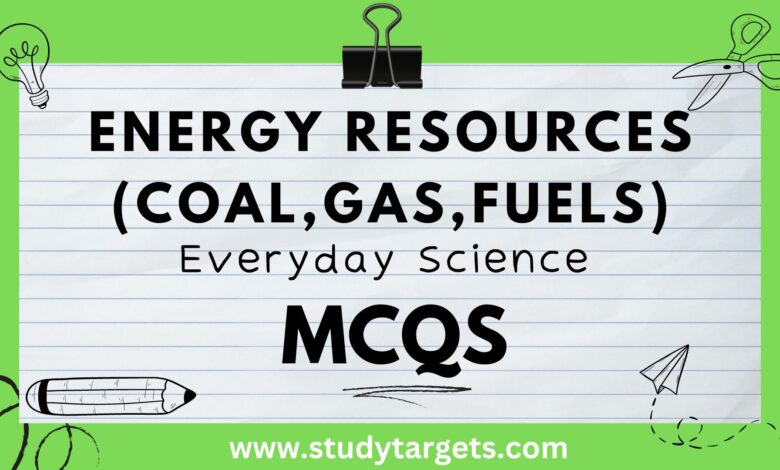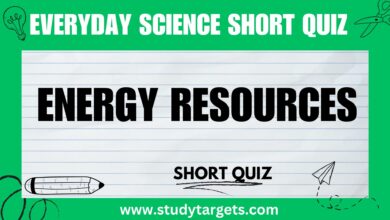MCQs: Energy Resources (Coal,Gas,Fuels): Everyday Science MCQs

Energy Resources (Coal,Gas,Fuels)
1. What is the most abundant and widely used energy resource in the world?
a) Nuclear energy
b) Solar energy
c) Fossil fuels
d) Wind energy
Answer: c) Fossil fuels
2. Which renewable energy resource harnesses the heat generated by the Earth’s core?
a) Geothermal energy
b) Biomass energy
c) Hydroelectric energy
d) Tidal energy
Answer: a) Geothermal energy
3. The process of converting sunlight into electricity using photovoltaic cells is known as:
a) Solar thermal power
b) Wind power
c) Nuclear power
d) Solar photovoltaic power
Answer: d) Solar photovoltaic power
4. Which fossil fuel is primarily composed of ancient marine organisms and is commonly used for electricity generation and heating?
a) Coal
b) Natural gas
c) Crude oil
d) Peat
Answer: a) Coal
5. Which renewable energy resource converts the kinetic energy of moving water into electricity?
a) Geothermal energy
b) Biomass energy
c) Hydroelectric energy
d) Tidal energy
Answer: c) Hydroelectric energy
6. What is the process called when heavy atomic nuclei split into smaller nuclei, releasing a large amount of energy?
a) Nuclear fusion
b) Nuclear fission
c) Geothermal heating
d) Solar radiation
Answer: b) Nuclear fission
7. The energy stored in the nucleus of an atom is called:
a) Nuclear energy
b) Geothermal energy
c) Solar energy
d) Wind energy
Answer: a) Nuclear energy
8. Which renewable energy resource uses the Earth’s gravitational pull on the moon to generate electricity?
a) Geothermal energy
b) Biomass energy
c) Hydroelectric energy
d) Tidal energy
Answer: d) Tidal energy
9. Which energy resource is derived from organic materials such as plants, animal waste, and wood?
a) Nuclear energy
b) Solar energy
c) Fossil fuels
d) Biomass energy
Answer: d) Biomass energy
10. What is the process of extracting heat from the Earth’s interior for heating and electricity generation called?
a) Geothermal heating
b) Nuclear fission
c) Solar photovoltaic power
d) Wind power
Answer: a) Geothermal heating
11. Which renewable energy resource uses the sun’s heat to generate electricity?
a) Geothermal energy
b) Biomass energy
c) Solar thermal power
d) Tidal energy
Answer: c) Solar thermal power
12. What is the primary component of natural gas?
a) Methane
b) Carbon dioxide
c) Ethanol
d) Propane
Answer: a) Methane
13. Which fossil fuel is a liquid hydrocarbon mixture extracted from the ground and refined into various products?
a) Coal
b) Natural gas
c) Crude oil
d) Peat
Answer: c) Crude oil
14. What is the process of combining lightweight atomic nuclei to form heavier ones, releasing a large amount of energy?
a) Nuclear fusion
b) Nuclear fission
c) Geothermal heating
d) Solar radiation
Answer: a) Nuclear fusion
15. Which renewable energy resource harnesses the power of wind to generate electricity?
a) Geothermal energy
b) Biomass energy
c) Wind energy
d) Tidal energy
Answer: c) Wind energy
16. The energy produced from burning wood and other organic materials is an example of:
a) Nuclear energy
b) Solar energy
c) Fossil fuels
d) Biomass energy
Answer: d) Biomass energy
17. What is the energy resource formed from the remains of ancient plants and animals that were buried and subjected to heat and pressure over millions of years?
a) Natural gas
b) Coal
c) Crude oil
d) Uranium
Answer: b) Coal
18. Which renewable energy resource involves harnessing the natural heat and steam produced by the Earth’s core?
a) Geothermal energy
b) Biomass energy
c) Hydroelectric energy
d) Tidal energy
Answer: a) Geothermal energy
19. The energy produced from capturing and utilizing the kinetic energy of ocean tides is known as:
a) Geothermal energy
b) Biomass energy
c) Hydroelectric energy
d) Tidal energy
Answer: d) Tidal energy
20. Which energy resource is commonly used in nuclear power plants to produce electricity?
a) Uranium
b) Natural gas
c) Crude oil
d) Coal
Answer: a) Uranium




